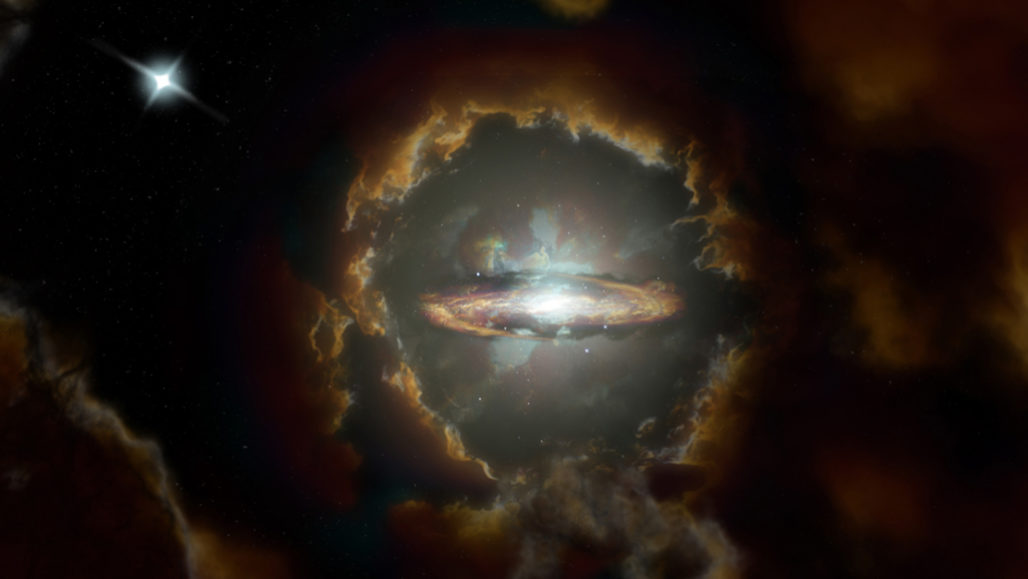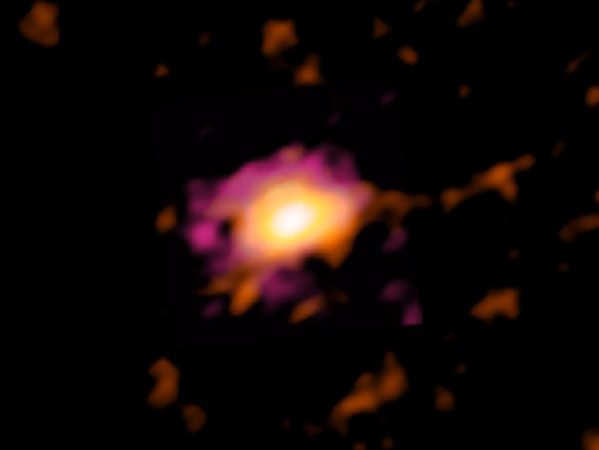Oldest disk galaxy puts a new spin on galaxy growth
Its spiral structure was in place early — just 1.5 billion years after the Big Bang

A spiral galaxy called the Wolfe Disk is shown in this artist’s illustration. Its spiral shape formed not long after the birth of the universe.
S. Dagnello/NRAO, AUI, NSF
Astronomers have spotted the oldest disk galaxy they’ve ever seen. Shaped like a pancake, it’s been around for billions of years. In fact, this galaxy got its flat shape a mere 1.5 billion years after the universe was born.
That’s far earlier than astronomers had expected.
The universe was born as a single point in what is known as the Big Bang. It then stretched like an inflated balloon. Scientists think the Big Bang happened about 13.8 billion years ago. A little more than a billion years later, there’s this pancake galaxy.
Scientists had thought the type of pancake galaxy just seen would not develop for at least 3 billion to 4 billion years after the Big Bang.

This galaxy is disk-shaped, just like the Milky Way galaxy in which we live. Our galaxy has spiral arms. The old galaxy may have those too. That’s important to note. It means that the old disk galaxy formed its pancake shape and spiral structure pretty quickly after the Big Bang. It suggests galaxies like the Milky Way can grow up relatively quickly, astronomers now say.
Marcel Neeleman works at the Max Planck Institute for Astronomy in Heidelberg, Germany. He headed a team of astronomers that reported the new find May 21 in Nature.
Such an old disk galaxy “challenges the accepted paradigm [PAIR-uh-dyme] for how disk galaxies form and evolve in the universe,” says Rachel Somerville. She is an astrophysicist and works at the Flatiron Institute in New York City. She was not involved with the new study.
The accepted idea had been that the earliest galaxies probably where not flat but shaped like a ball. The galaxies were made with the help of dark matter. That’s invisible stuff in the universe. We don’t know what it is yet. Still, dark matter has mass. So it could pull in surrounding gas and dust to make stars.
As more material got pulled in, galaxies that were round and blobby emerged. At least, that’s what astronomers had observed before. It’s also what computer models suggest. Theory had suggested that creating those early galaxies was a violent process. Gas got scrambled and heated. Hot gas expands. That should make the early galaxies spherical blobs. They were too hot for the gas to settle into a disk. Only when that gas had lots and lots of time to cool off should it collapse into bright, starry disk galaxies.
Or so researchers thought.
Changing the picture
Over the past 15 years, computer models have shown that cold streams of gas could sneak into ancient, blobby galaxies. That would potentially make it easier for disk galaxies to arise —and do it quickly. Astronomers call this process cold accretion (Uh-KREE-shun).
And, astronomers wanted to see if it actually occurs in the universe. So astronomer Marcel Neeleman and colleagues went hunting for the earliest disk galaxies they could find.
Most early galaxies are too far away for Earth-based telescopes to catch light from their stars. But with the help of quasars, sensitive radio telescopes can detect light from much more distant galaxies. Quasars are blazing, white-hot disks. They surround supermassive black holes. Their light can filter through a closer galaxies’ gas. It just so happened there was a bright quasar called DLA0817g behind the early disk galaxy. It allowed astronomers to see the galaxy’s silhouette. That revealed its contents and structure.
The first hints Neeleman and his colleagues had of DLA0817g came in 2017. They were looking for distant disk galaxies with the Atacama Large Millimeter/submillimeter Array in Chile. They spotted DLA0817g with this radio telescope. And then they looked at it again last year. Those observations showed that the galaxy is rotating like a vinyl record: Half of the galaxy’s gas is moving away from Earth, and half is moving toward us.
That motion was a sure sign that the galaxy is a cold, flat rotating disk. It likely has spiral arms, too, the scientists say — just like the Milky Way.

Educators and Parents, Sign Up for The Cheat Sheet
Weekly updates to help you use Science News Explores in the learning environment
Thank you for signing up!
There was a problem signing you up.
Big spinner
The Milky Way tips the scales at 1.5 trillion solar masses. At roughly 72 billion times the mass of the sun, DLA0817g seems tiny. Still, we’re seeing the galaxy as it was billions of years ago. It had not yet had as much time to bulk up as the Milky Way has. And so, compared to galaxies around it, DLA0817g is massive.
It’s one of a few behemoth galaxies spotted in the early universe. They’re surprising to see. That’s because growing a massive galaxy of any shape so quickly is challenging, notes coauthor J. Xavier Prochaska. He’s an astronomer at the University of California, Santa Cruz. What also makes DLA0817g intriguing is the site of this ancient quasar. “The shocker,” he says, “is to see one in a nice spiral disk.”
The big, distant galaxy is dubbed the Wolfe Disk. It is named after astrophysicist Arthur Wolfe of the University of California, San Diego. Wolfe died in 2014. He had been one of the first to suggest disk galaxies existed in the infant universe. Many scientists were skeptical, says Prochaska, who studied with Wolfe as a graduate student.
“He was right, at least partially,” Prochaska now says. “He deserves credit for having planted that flag against all conventional wisdom.”







